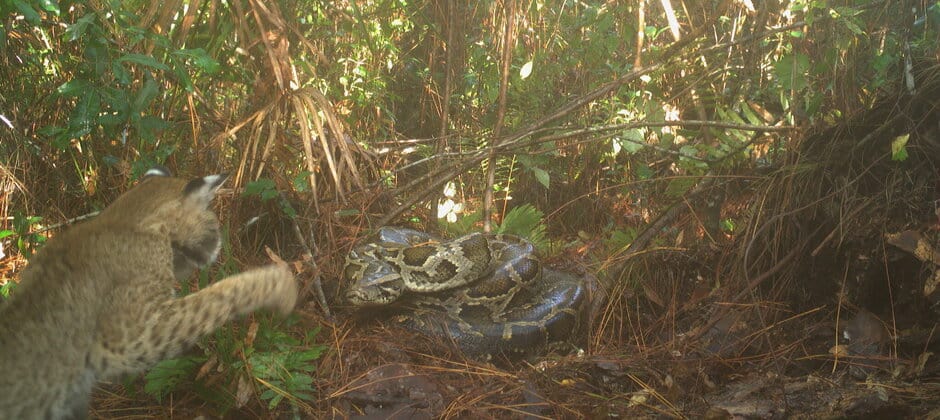Share this article
Bobcat preys on Burmese python eggs in Everglades
First-of-its kind footage reveals that bobcats may prey on invasive Burmese python eggs in southern Florida. While the video showed only a one-off confirmed case, the discovery reveals that some native wildlife may be able to fight against the spread of the disruptive predators.
“The more of those types of things that we can see, the stronger the case that maybe the Everglades is fighting back,” said Andrea Currylow, south Florida field studies lead with the U.S. Geological Survey.
Currylow and her colleagues were tracking Burmese pythons (Python bivittatus) as part of a scout snake study. With this method, formerly referred to as the Judas technique, researchers trap male Burmese pythons and fit them with tracking devices to learn more about their habits. Then, the researchers can follow the males to breeding aggregations during the winter and spring, helping managers to find and remove more of the invasive snakes. More recently, researchers began fitting adult females with devices to learn more about their life habits, given that females drive population increases.
“We weren’t sure what to expect—we wanted to monitor nesting behavior,” Currylow said.
Two females they fitted with tracking devices nested during the first year of the study in 2021. They tracked the pythons to their nests and placed trail cameras nearby to learn more about what happened during this critical point in pythons’ life history.
In a study published recently in Ecology and Evolution, Currylow and her colleagues reported that, initially at least, they didn’t see much action. The nesting females moved so little—or so slowly—that they didn’t even trigger the motion detection devices on the cameras.
But suddenly the camera was triggered. It wasn’t the adult female snake setting it off—the serpent was absent. It was an interloping bobcat (Lynx rufus). The wild cat first investigated the nest then later began to dine on the eggs. “It very slowly began to devour the nest,” Currylow said. The feline even cached some of the eggs and came back over several days for leftovers.
Based what they saw in the photos, the researchers assumed the bobcat seemed privy to the potential danger. “If you watch the video that we put together from a stream of photographs, it shows the bobcat was really aware of its surroundings,” Currylow said. And for good reason—the snake was never detected more than 10 meters away from its nest.
Lucky for the bobcat. The snake was nearly 14 feet long and weighed 120 pounds, while the bobcat was only an estimated 20 pounds. “It was really surprising—[the snake] was 100 pounds heavier than we estimated that bobcat to be,” Currylow said, adding that the snake was large enough to strangle and consume the feline.
The bobcat eventually did encounter the python on camera, and the meeting appeared less than collegial. The bobcat even swiped at the large snake with its paw. Currylow said the photo they captured is the first on-camera evidence of antagonistic action in Florida between pythons and anything other than humans.
It’s still unclear how often bobcats prey on the eggs inside python nests, or pythons themselves. Research presented at The Wildlife Society’s virtual 2021 Annual Conference previously showed that on tree islands in the Everglades, pythons may limit bobcat presence. This still may be true in general, or in certain areas of the Everglades. But a previous study reported a case of a bobcat preying on 10-foot male python, and another case showed that a black bear (Ursus americanus) attacked a snake as well, though the reptile survived the latter encounter.
Currylow is excited to track pythons again next nesting season in June and July. But for now, the trail camera footage captured by Currylow and her team reveals that bobcats may finally be rallying a defense against the invasive species. Or at least the relationship isn’t quite as simple as initially believed.
“The python problem is so huge, that any little glimmer of hope that the Everglades might be resilient to this invader—it’s just inspiring,” Currylow said.
Header Image: The only photo evidence known to exist of a dicey bobcat encounter with an adult female Burmese python. Credit: Andrea Currylow/USGS








